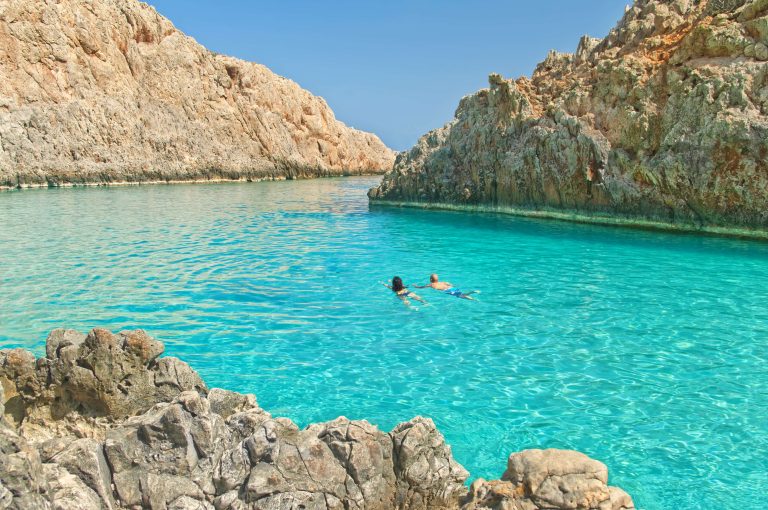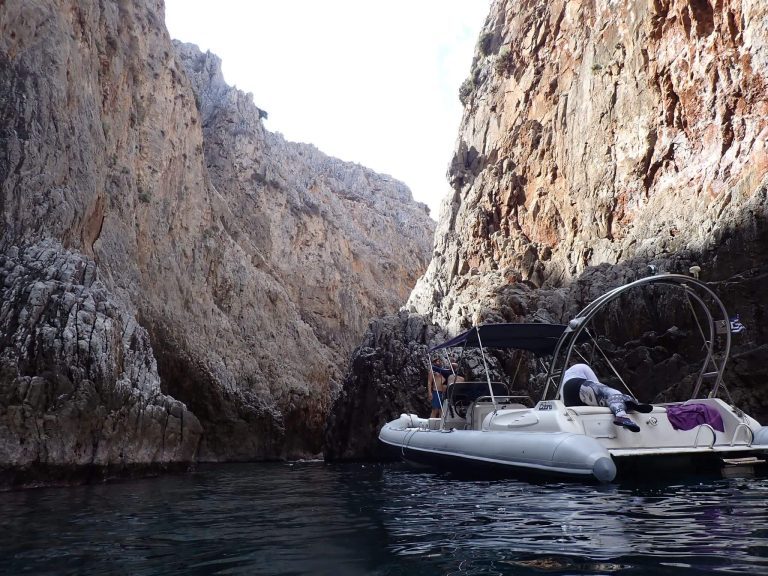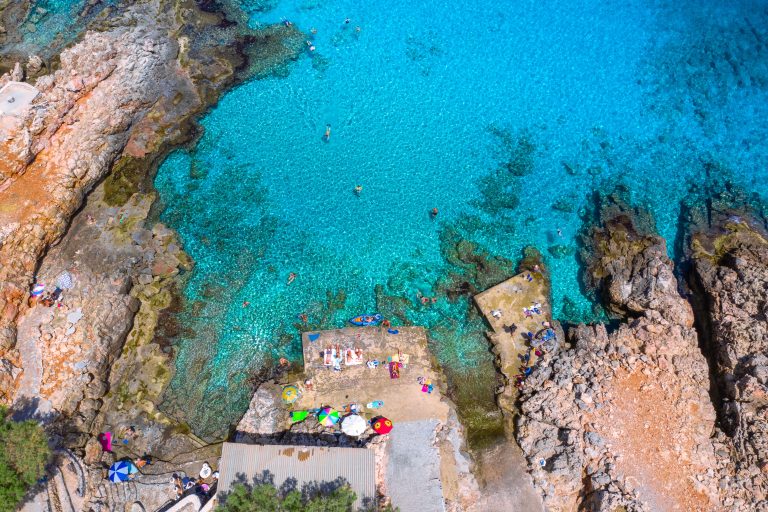Katholiko Beach
The Ultimate Traveler’s Guide to Katholiko
Introduction
Tucked away from the bustling tourist spots, Katholiko Beach is a hidden treasure nestled on the rugged Akrotiri Peninsula of Crete, not far from the vibrant city of Chania or Chania International Airport. This secluded cove is unlike any other on the island, not because of soft sand or organized amenities, but for its wild beauty, historic depth, and spiritual calm.
Reaching Katholiko Beach is an adventure in itself. The only way to access it by land is by driving 20 km from Chania and then by hiking through a strenuous 2.5 km winding trail.
Alternatively, you can reach Katholiko Beach by private boat tour, offering a more relaxed but equally breathtaking way to experience this remote location. These tours typically explore the stunning Akrotiri coastline, known for its dramatic cliffs, secret caves, and vivid turquoise waters. Many itineraries include stops at famous spots like Seitan Limania, a narrow fjord-like beach with surreal waters, and Stavros, a sandy cove made famous by the film Zorba the Greek. From the sea, Katholiko reveals another side of its beauty. Its towering rock walls and secluded inlet seen from the water are a sight to behold.
Whether you prefer to hike through history and wilderness, or cruise along the coastline with a local skipper, Katholiko Beach offers a truly unforgettable escape.
This guide provides everything you need to know about Katholiko Beach, from its history to tips on how to get there, things to do, and essential travel advice. Follow this guide to make the most of your visit.
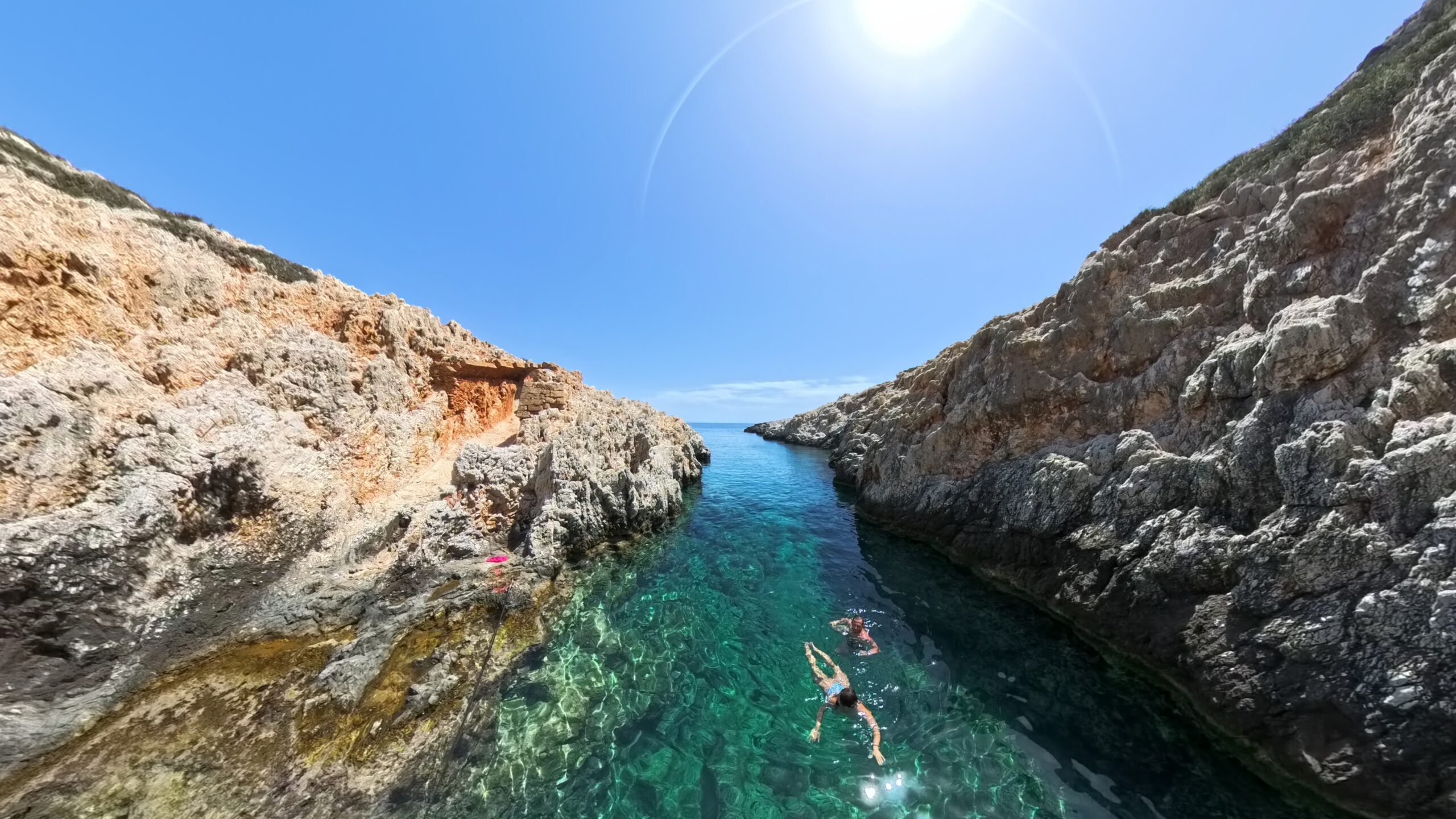
History and Origins
Katholiko Beach is more than just a hidden natural gem—it’s steeped in centuries of spiritual and maritime history. The area formed part of a significant monastic complex during the Byzantine and Venetian periods, centered around the now-abandoned Katholiko Monastery, which lies just above the beach, carved into the cliffs of the Avlaki Gorge. Built in the 11th century, this monastery is believed to be the oldest in Crete, founded by St. John the Hermit, a revered ascetic who sought isolation in the caves and wild terrain of Akrotiri.
During the centuries the gorge served as a remote religious center where monks lived in solitude, dedicating their lives to prayer and self-denial. Katholiko Beach, located at the mouth of the gorge, was used by the monks as a small port. It offered a discreet and practical point of access to the sea, used for fishing, receiving goods, and perhaps even spiritual reflection by the water.
However, by the 17th century, the monastery was gradually abandoned due to persistent pirate raids along the Cretan coasts, which rendered the area too dangerous for monastic life.
Today, the remnants of this sacred past still stand, weathered by time but profoundly evocative. As you descend the trail or approach from the sea, you’ll walk through (or sail past) layers of Cretan religious heritage, Byzantine resilience, and a deep-rooted connection between man, faith, and nature. Katholiko is not just a beach, it’s a silent witness to over a thousand years of spiritual history carved into the cliffs.
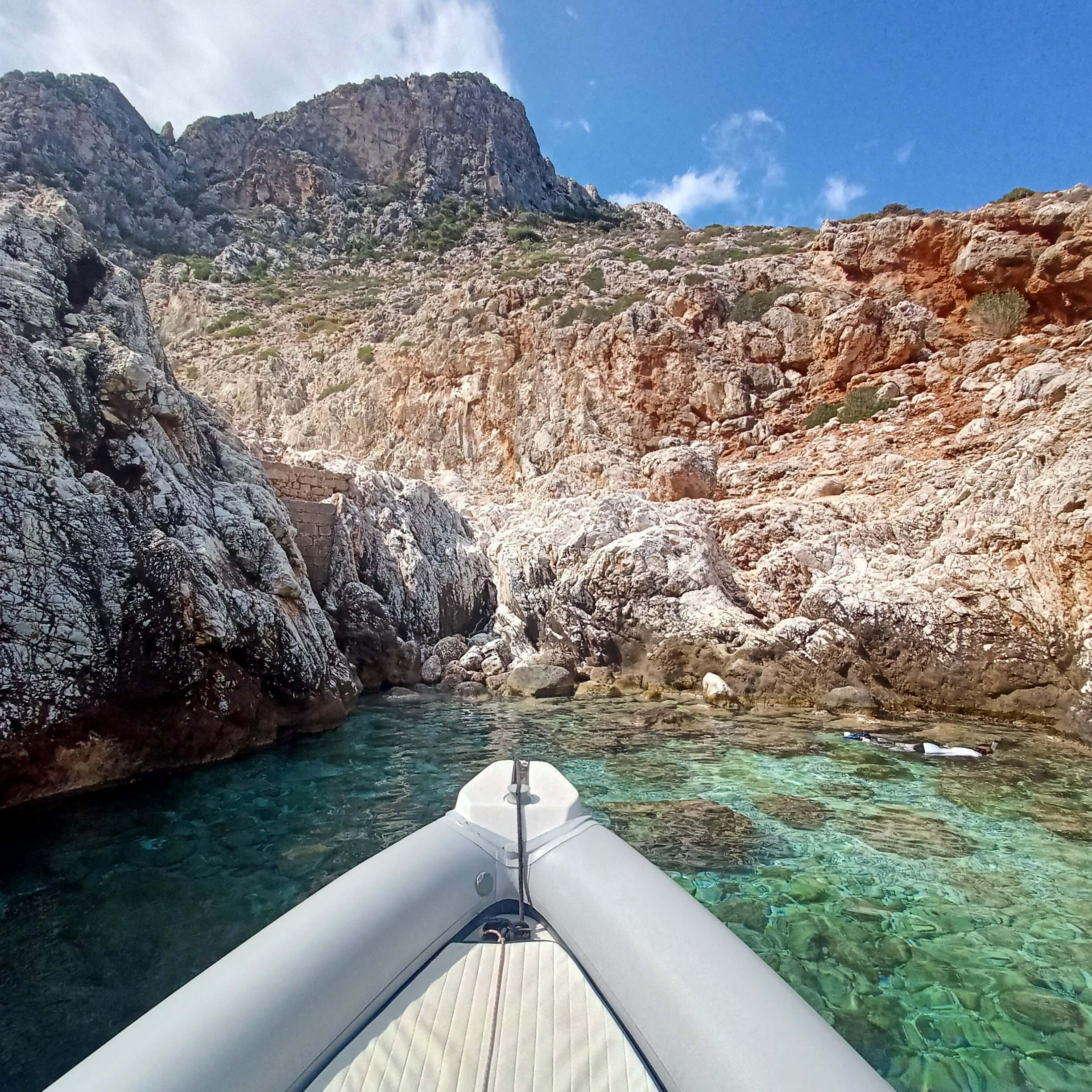
Things to do at Katholiko Beach
Enjoy Beach Activities
Swimming and Snorkeling
Although Katholiko Beach is small and narrow, it offers a truly unique and rewarding swimming experience, especially for those who love crystal-clear waters and total seclusion. Nestled between towering limestone cliffs, the beach forms a narrow inlet where the sea is calm, glassy, and deep, even close to shore. The water here boasts a striking azure-blue hue, intensified by the rocky seabed and the filtered light bouncing off the canyon walls.
There is no sand here, the shoreline is entirely rocky, so it’s best to bring water shoes or sandals to protect your feet when entering and exiting the water. This sheltered cove is perfect for snorkeling, especially along the rugged edges of the inlet where marine life flourishes. Visibility is excellent, often exceeding 20 meters on clear days, making it easy to spot colorful fish, sea urchins, starfish, and occasionally octopuses hiding in crevices.
Cliff Jumping
For thrill-seekers and adventurous souls, Katholiko Beach offers an exhilarating opportunity for cliff jumping, thanks to its natural rock formations and deep, clear waters. The narrow inlet is flanked by steep limestone cliffs, some of which rise several meters above the sea, creating natural platforms for jumps of various heights. The depth of the water, even close to the shoreline, generally makes jumping safe but only with caution and proper judgment.
The most commonly used spots are located near the northern wall of the cove, where the rock provides flat ledges and unobstructed take-off points. Before jumping, it is crucial to inspect the area below for underwater rocks or changes in depth, as the seabed is uneven and the clarity of the water, while beautiful, can sometimes be deceptive. Bear in mind that cliff jumping here isn’t officially regulated or supervised, so it’s important to take full personal responsibility and never jump alone.

DCIMCamera01IMG_20240617_113912_00_311.ins
Visit the surrounding historical spots through a hike
The hike from Gouverneto Monastery to Katholiko Beach (or the more strenuous reverse direction) is not just a scenic trek, it’s a walk through centuries of Cretan history, natural wonders, and spiritual heritage.
The trail (2.5 km one way), from Governeto Monastery is mostly downhill on the way to the beach. However, bear in mind that if you choose to hike on foot from Katholiko Beach to Gouverneto Monastery, the path becomes a steady and sometimes tiring ascent, especially under the midday sun. Plan for around 1.5 to 2 hours total walking time (down and back), not including breaks.
Along the way, you’ll encounter a remarkable series of sites that blend myth, faith, and geology, all set against the dramatic backdrop of the Avlaki Gorge. Here’s what you’ll discover on your descent:
Gouverneto Monastery
If you drive from Chania to the region, you’ll arrive at Gouverneto Monastery where you’ll have to park your car (parking space on Google Maps). Gouverneto Monastery is one of the oldest active monasteries on Crete, founded in the 16th century during the Venetian era.
Perched at the edge of the Akrotiri Peninsula, the monastery features impressive fortress-like architecture, a beautiful Renaissance-style church, and a tranquil courtyard surrounded by cypress trees. Its peaceful setting makes it a fitting start to the spiritual trail ahead. A small entrance fee of €2.50 per person, and respectful attire is required. After passing the monastery you find the starting point of the trail that leads you to the beach (the trail’s starting point on Google Maps).
Arkoudiotissa Cave (Bear Cave)
A short walk from the monastery (1.4 km | 20 mins) leads to Arkoudiotissa Cave, named after a large stalagmite that resembles a sitting bear. In ancient times, this cave was a place of worship for Artemis, the goddess of the wilderness, and later adopted as a Christian hermitage dedicated to the Virgin Mary. You’ll see carved niches, traces of frescoes, and stone altars inside—testaments to its long religious significance. The mystical atmosphere here is enhanced by shafts of sunlight filtering through the cave’s openings.
Katholiko Monastery (Monastery of St. John the Hermit)
Continuing deeper into the gorge, you’ll reach the Katholiko Monastery, a breathtaking 11th-century complex built into the cliffside itself. Founded by St. John the Hermit, this now-abandoned monastery is considered the oldest in Crete. It includes a stone bridge, a small Byzantine church, monk cells carved into the rock, and cisterns used for collecting rainwater. Standing here feels like stepping back in time, surrounded by silence, birdsong, and the enduring presence of spiritual devotion carved into stone.
The Avlaki Gorge Trail
The entire hike runs through the Avlaki Gorge, a dramatic limestone canyon filled with wild herbs, carob trees, and the occasional view of hawks or mountain goats above. The path can be steep and rocky in places, but it’s well-marked and bursting with natural beauty. Take your time, breathe in the scent of thyme and sage, and listen to the wind moving through the cliffs. The gorge itself feels like part of the sacred landscape, untouched, wild, and resonating with centuries of quiet pilgrimage.
At the end of your hike, you’ll be rewarded with a hidden rocky cove, the secluded and unspoiled Katholiko Beach.
Take a Day Trip with a Private Boat Tour
If hiking through rocky gorges isn’t your style, or you’re simply looking for a more relaxing way to explore Crete’s hidden treasures, a private boat tour to Katholiko Beach is a fantastic alternative. These tours depart from Chania Old Port, Marathi, or Loutraki, and offer a scenic and comfortable route to reach otherwise inaccessible spots along the stunning Akrotiri Peninsula. Popular stops often include Seitan Limania, Stavros Beach, and of course, the remote and serene Katholiko Beach.
The Akrotiri coastline is a spectacle of natural beauty. As you sail along the shore, you’ll encounter towering cliffs, hidden sea caves, and crystal-clear coves, all set against the brilliant blue of the Cretan Sea. Βoat tours offer several stops for swimming, snorkeling, and sunbathing in quiet, pristine bays.
One of the highlights is experiencing Katholiko Beach from the water. Its narrow rocky inlet, flanked by steep cliff walls, takes on an even more dramatic character when viewed from the sea. Fewer visitors reach the beach this way, which means you might enjoy peaceful swimming, picnicking on the rocks, or simply soaking in the silence with hardly anyone around.
If you interested in exploring Katholiko beach by a private boat, you should join us on our private “Seitan Limania & Katholiko Bay Private Tour from Chania”, a 4 hour cruise from Chania Town where you’ll have the opportunity to explore the outstanding Seitan Limania, Katholiko Beach with its wild beauty and the secluded bay of Macherida.
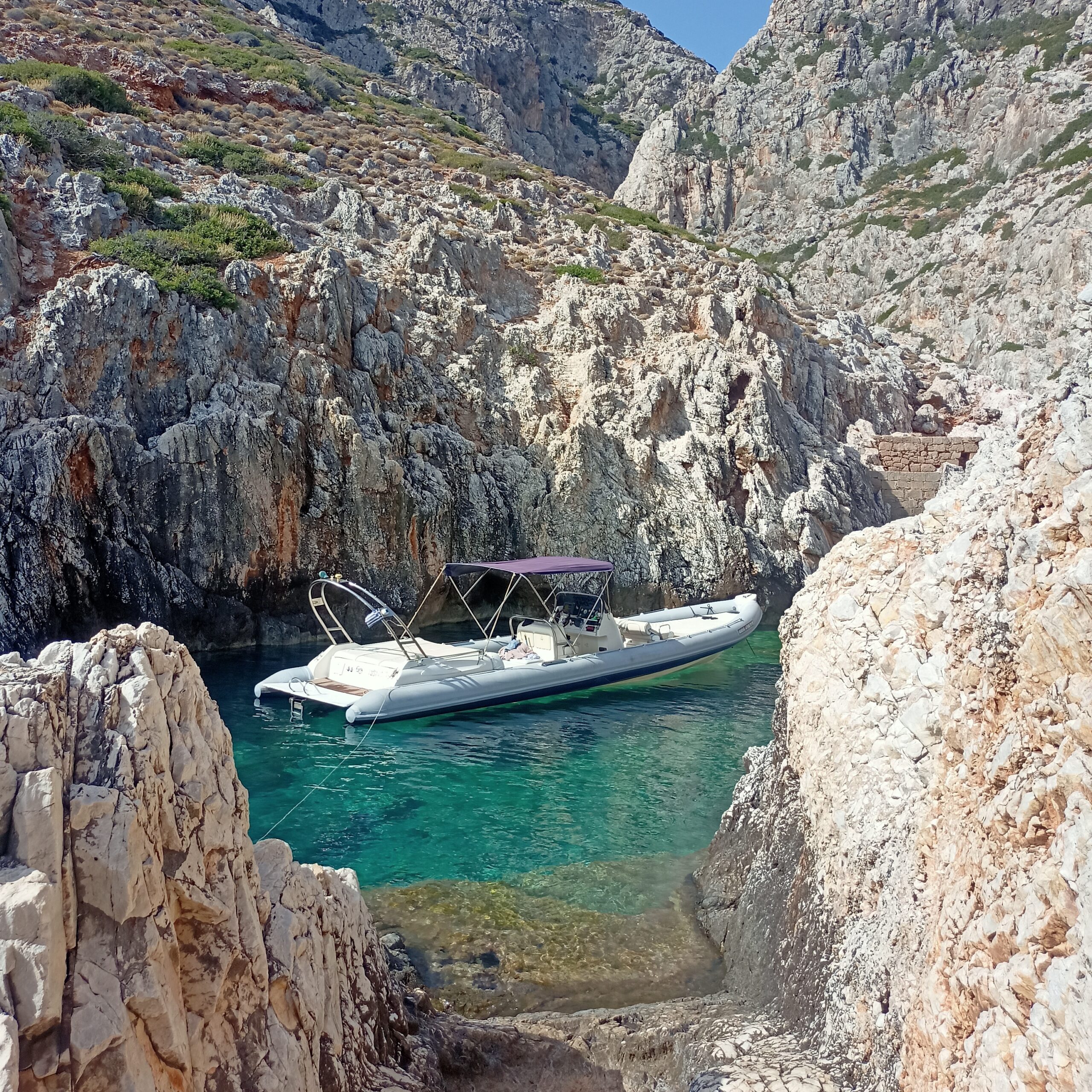
Nearby Attractions
While Katholiko Beach is a rewarding destination on its own, the surrounding Akrotiri Peninsula offers a wealth of attractions worth exploring. Whether you’re looking for natural beauty, historical landmarks, or iconic beach experiences, these nearby spots are ideal additions to your day trip or extended stay in the region.
Seitan Limania Beach (Stefanou Beach)
Tucked into a steep, rocky gorge on the northeastern tip of Akrotiri, Seitan Limania Beach (open in google maps) is one of Crete’s most photogenic, not-to-miss, dramatic coastal spots. The beach is set at the end of a narrow, zigzagging inlet, where turquoise waters cut through rugged limestone cliffs. Its name means “Devil’s Ports,” a reference to the wild, unpredictable sea just beyond the protected cove. Despite the ominous name, the beach itself is usually calm and perfect for swimming, with crystal-clear waters and incredible visibility.
To reach the beach by land, visitors must navigate a winding mountain road followed by a steep and rocky footpath. Although the hike down takes only about 10 to 15 minutes, it can be challenging in flip-flops or for those unsteady on their feet.
Alternatively, many private boat tours include Seitan Limania as a stop, allowing for easy access from the sea and offering stunning coastal views. If you want to indulge in a captivating 6-hour private boat tour to the stunning Akrotiri coastline including Seitan Limania Beach and Katholiko Beach, you should follow “Seitan Limania and Akrotiri Cape Round Tour from Chania”.
For all the updated information about Things to do at Seitan Limania Beach, How to get there and other Essential Tips, don’t forget to check our detailed “The Ultimate Traveler’s Guide to Seitan Limania Beach (Stefanou Beach)”.
Stavros Beach
Located on the northwestern edge of the Akrotiri Peninsula, Stavros Beach (open in google maps) combines cinematic fame with laid-back seaside charm. It gained international attention when it appeared in the iconic 1964 film Zorba the Greek, where Anthony Quinn danced the famous syrtaki on its golden sands. Today, Stavros is a peaceful and accessible beach that appeals to families, couples, and those seeking a relaxed day by the sea.
The beach features a sheltered, circular bay with shallow, calm waters and fine sand, making it especially suitable for young children and casual swimmers. A distinctive rocky hill rises on one side of the bay, adding a dramatic visual element while helping block strong winds and waves. Unlike Katholiko or Seitan Limania, Stavros Beach is fully developed, offering sunbeds, umbrellas, nearby tavernas, and basic facilities within walking distance. You can enjoy a cold drink or traditional Cretan lunch just steps from the shore. For those interested in light hiking, a short trail near the beach leads to the top of the rocky hill, offering panoramic views of the coastline.
Monastery of Agia Triada Tsangarolon
Located just a short drive from Chania (17 km away) on your way to Gouverneto Monastery and Katholiko Beach, the Monastery of Agia Triada Tsangarolon (open in google maps) is one of the most elegant and historically significant monasteries in Crete. Nestled among olive groves and rolling hills, its architecture is a harmonious blend of Venetian influence and Orthodox tradition, with a striking façade, arched colonnades, and a spacious courtyard filled with fragrant citrus trees and blooming flowers.
Today, it remains an active monastic community known for producing organic olive oil, wine, honey, and traditional soap, all of which can be purchased at the small shop on-site. Visitors can also explore a museum containing rare manuscripts, icons, and ecclesiastical artifacts.
Responsible Travel and Sustainability
Katholiko Beach and the surrounding Akrotiri Peninsula are places of rare natural beauty and deep cultural heritage. Because of their fragile ecosystems, historical significance, and remote character, it’s essential for visitors to explore the area with respect and care. Below are several key ways you can travel responsibly and help preserve this special destination for future generations.
Leave No Trace
With no facilities at Katholiko Beach or along the trail, everything you bring in must also be carried out. Take all rubbish with you, including biodegradable waste like fruit peels. Avoid single-use plastics when possible. Bring a reusable water bottle and containers. If nature calls, find a discreet spot away from the trail or beach and use natural waste disposal methods responsibly (carry tissues or toilet paper out in a sealed bag).
Respect the Natural Environment
Katholiko Beach lies in a remote, untouched gorge where wildlife, native plants, and geological formations thrive. To protect this environment stay on marked paths during the hike to avoid trampling fragile vegetation or disturbing animal habitats. Do not remove rocks, plants, or natural souvenirs from the area. Avoid loud music, shouting, or disruptive behavior that could unsettle wildlife or other visitors seeking peace and quiet.
Protect Cultural and Historical Sites
The trail to Katholiko passes through centuries-old monastic ruins, including Katholiko Monastery, one of the oldest in Crete. These ruins are unguarded and vulnerable. So, do not climb on or lean against ancient structures, walls, or arches. Refrain from carving initials or leaving graffiti. Respect the sanctity of religious spaces, even if they are no longer active. If visiting active monasteries like Gouverneto or Agia Triada, dress modestly and behave respectfully.

Essential Tips for Visitors
Best Time to Visit
The best seasons to visit Katholiko Beach are spring (April to June) and autumn (September to early November). During these months, the weather is mild, the landscape is green, and the hiking conditions are more comfortable. Summer is also possible but be prepared for intense heat and little to no shade along the trail. Early mornings are ideal to avoid sun exposure, especially if you’re planning to hike.
Parking
If you are reaching the area by car, the best place to park is at the Gouverneto Monastery, which marks the trailhead for the hike to Katholiko Beach. The parking area is small but free (parking space on Google Maps), and spots are usually available outside of peak hours. Arrive early during the summer months to secure a spot and enjoy a more peaceful experience.
Please respect the monastery grounds by parking in designated spaces only and avoiding loud noise.
Trail Safety
The trail from Gouverneto Monastery to Katholiko Beach is around 2.5 kilometers one way, descending through Avlaki Gorge. While the path is clear and marked, it includes rocky, uneven terrain and steep sections that can be physically demanding. Allow 45 minutes to 1 hour for the descent and more time for the return ascent, which is tiring and fully exposed to the sun. Do not attempt the hike in flip-flops or casual shoes. Avoid hiking in the middle of the day during the summer. Always bring more water than you think you’ll need. Avoid visiting after heavy rainfall, as the trail through the gorge may become slippery or unstable in places.
If you’re not confident with hiking in these conditions, consider visiting Katholiko by private boat, which offers a scenic and less physically demanding option.
Beach Shade
Katholiko Beach offers little to no natural shade, especially during midday hours. The beach is set between high cliffs, but the sun quickly rises above them and fully illuminates the cove. This means that staying at the beach for extended periods requires proper sun protection. There are no trees, umbrellas, or shaded spots.
Wind Conditions
Katholiko is located in a narrow, cliff-lined inlet, which usually keeps the beach well protected from wind and waves. However, strong north winds (Meltemia), common in summer, can affect the hike and make boat access less pleasant. If you’re planning a private boat tour, check wind conditions in advance, as some captains may reschedule or reroute depending on sea state.
What to Bring
Katholiko Beach and the surrounding trail have no facilities, so come fully equipped for a self-sufficient outing. Here’s what you should consider bringing: Plenty of water (at least 1.5–2 liters per person), Snacks or a light meal for the beach, Sturdy hiking shoes or trekking sandals, Sunscreen, hat, and sunglasses, Swimsuit and towel, Snorkeling gear if you want to explore underwater, Water shoes for easier access to the rocky shoreline, A small first aid kit, A fully charged phone (though signal may be limited in the gorge).
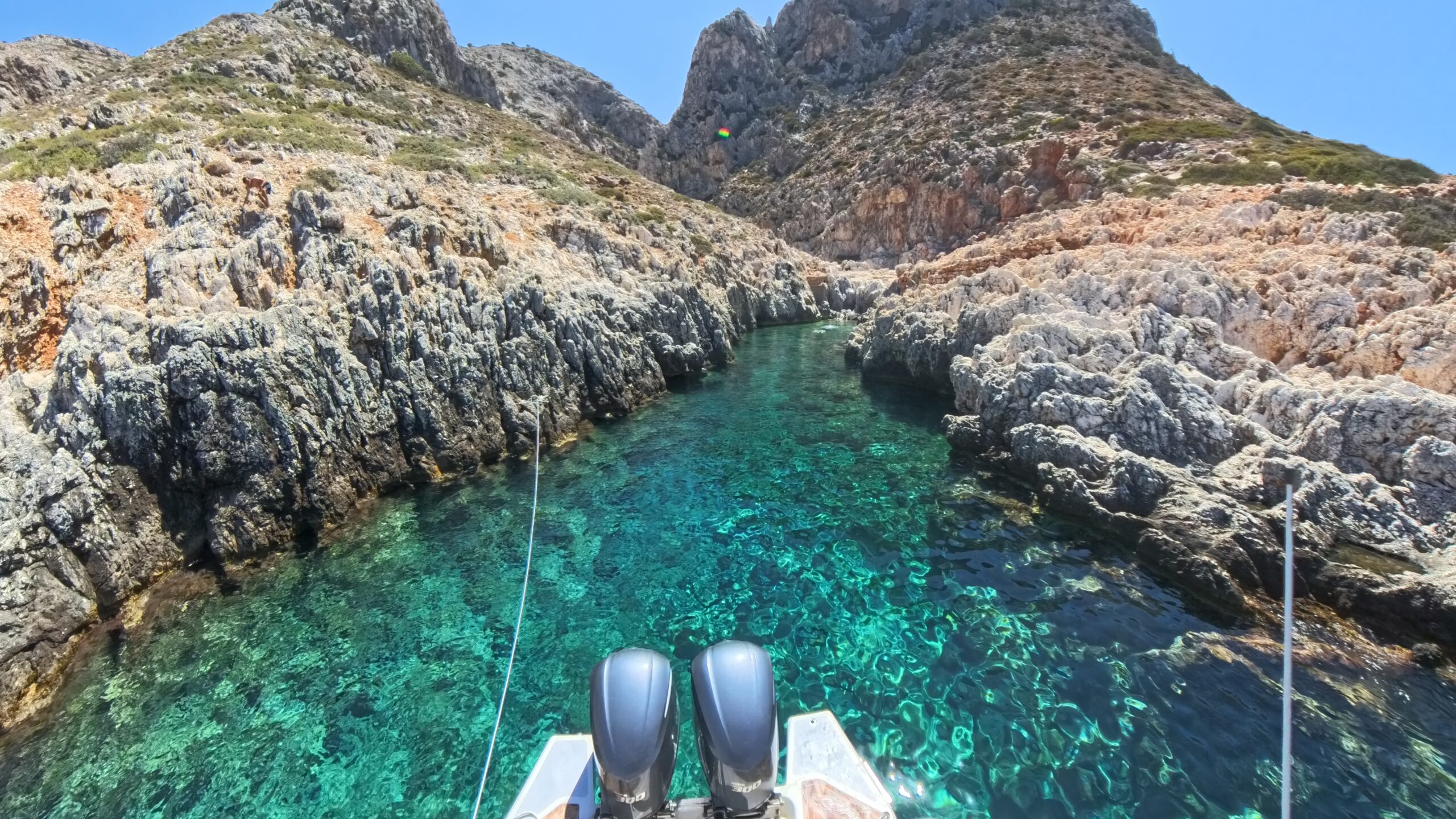
How to Get to Katholiko Beach
Katholiko Beach is one of the most secluded spots on the island of Crete, accessible only by foot or private boat. There are no roads leading directly to the beach, which has helped preserve its wild beauty and peaceful atmosphere.
Getting to Katholiko Beach by Car and Hiking
For those who choose to reach it on foot, the journey combines a scenic drive to the remote Gouverneto Monastery followed by a hike through the dramatic Avlaki Gorge, passing by ancient caves and ruins along the way. It’s an adventure that blends natural exploration with deep cultural and spiritual history, and the reward at the end is an untouched cove of crystal-clear water.
The parking space as well as the beginning of the trail to Katholiko Beach are at Gouverneto Monastery that is located 17 km away from Chania (around 30 min) and 8 km from Chania International Airport (15 min).
Route from Chania to Gouverneto Monastery
From Chania city center, begin your drive by heading east and following the main asphalt road known as Akrotiriou Street, which connects Chania with the Chania International Airport (CHQ) and the Akrotiri Peninsula. This is a well-maintained, straightforward road that passes through several residential and suburban areas.
As you continue along Akrotiriou Street and approach the airport zone, you’ll pass through the villages of Kounoupidiana, Korakies, and Aroni. Just before you reach the airport, look out for a signposted turn-off to the Monastery of Agia Triada Tsangarolon. Take this turn, and follow the narrow, scenic country road through olive groves and vineyards.
After visiting or passing Agia Triada Monastery, continue driving uphill for about 6 more kilometers toward Gouverneto Monastery. The road becomes narrower and more winding as you climb higher into the hills, offering panoramic views of the Akrotiri coast and countryside. Drive carefully and slowly, especially around tight curves (open google maps route).
Eventually, the road ends at the entrance of Gouverneto Monastery, where you will find a small parking area for visitors. This is the starting point of the hike to Katholiko Beach.
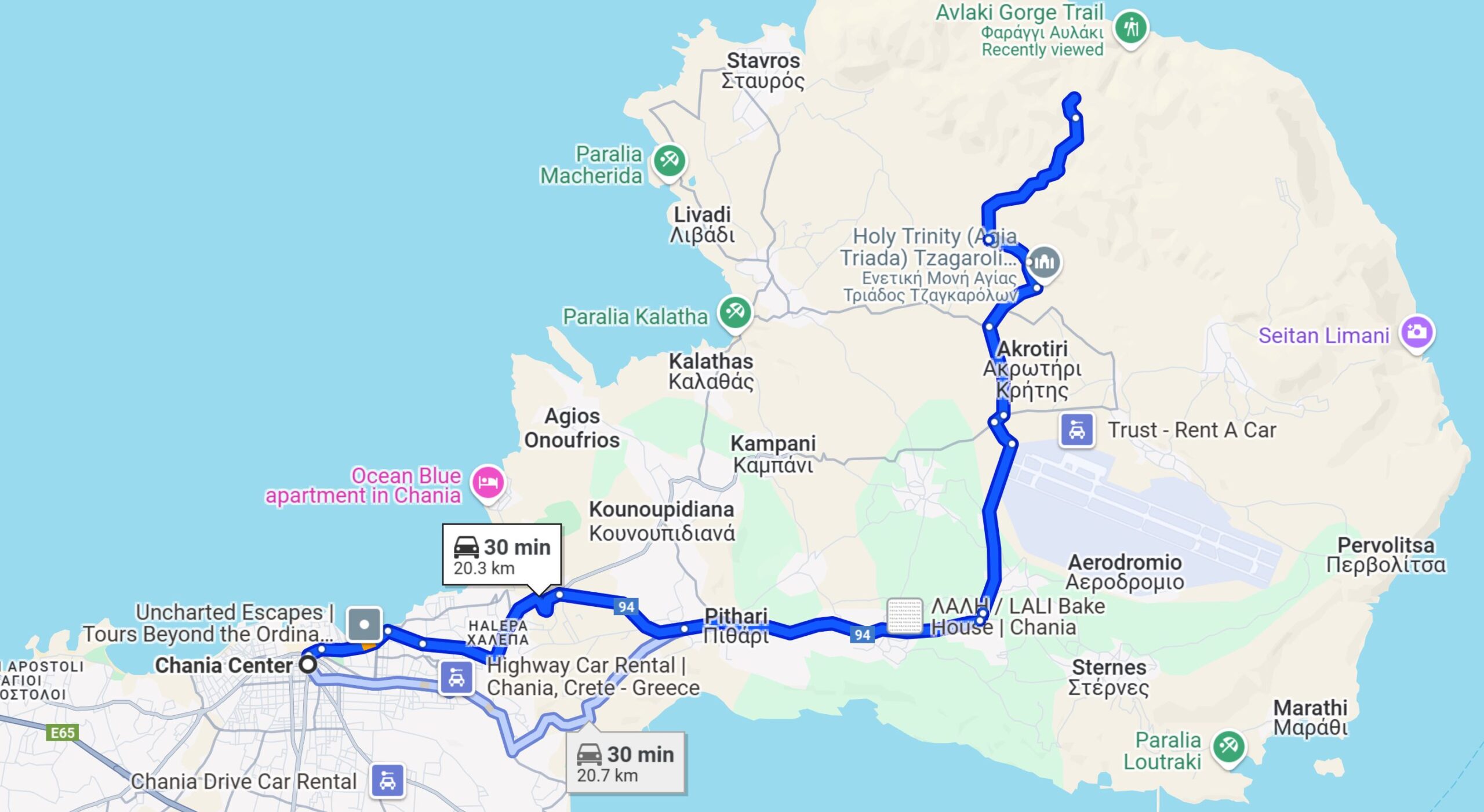
Driving Directions for Non-Chania Visitors
If you are not in Chania and you don’t want to enter the downtown of the city, you should drive through E75/VOAK, the national road that runs along the north coast of Crete. Head east from Chania to Rethymno and after about 10 km, take the exit “Souda Port / Chania Airport” toward the Akrotiri Peninsula and the Airport. Follow Signs to the Airport and before reaching it, turn left at the turn-off by following the above-mentioned description of the route.
The Hiking Part of the Route
The hike to Katholiko Beach begins just outside the entrance of Gouverneto Monastery, where a well-marked stone path leads into the Avlaki Gorge. This ancient trail takes you on a captivating journey through nature, history, and spirituality, offering a memorable descent to one of Crete’s most isolated beaches.
The full route to the beach is approximately 2.5 kilometers one way, with an elevation drop of around 260 meters (open google maps route). Plan for 45 minutes to 1 hour of descent, and more time for the uphill return. The descent is moderate, but the return hike is uphill and physically demanding, especially in warm weather. Start early to avoid the hottest hours of the day. The trail is clear and marked, but signage is minimal. Stick to the main path and allow time for photo stops and rest.

On your way to Katholiko Beach, you will pass by places of interest. About 10 minutes into the trail, you’ll reach Arkoudiotissa Cave (Bear Cave), a natural cave and early Christian hermitage. Roughly halfway down the trail, Katholiko Monastery, an 11th-century monastery appears as if carved from the cliff itself. Once a thriving center of ascetic life founded by St. John the Hermit, it now stands in peaceful ruin, with stone arches, a small bridge, and ancient monk cells blending into the landscape.
After the monastery, the trail continues through the narrow and wild gorge of Avlaki. You’ll pass through a rocky, shaded path filled with fragrant herbs, small shrubs, and incredible limestone formations. Along the way, you might see lizards, birds of prey, or wild goats climbing the cliffs. Eventually, the gorge opens into a narrow inlet, and you’ll arrive at the secluded Katholiko Beach.
Getting to Katholiko Beach by Boat
Accessing the beach from the sea offers a unique perspective of the dramatic cliffs and untouched coastline of the Akrotiri Peninsula, and it is the only other way to reach Katholiko besides hiking.
Katholiko Beach is located on the northeast coast of the Akrotiri Peninsula, east of Chania. Travel distances from nearby ports are approximately:
- From Chania Old Port: ~9 nautical miles (approx. 35–45 minutes by boat)
- From Marathi Port: ~6.5 nautical miles (approx. 25–35 minutes)
- From Loutraki Beach: ~6 nautical miles (approx. 20–30 minutes)
- From Stavros Beach: ~5.5 nautical miles (approx. 20–25 minutes)
These times may vary depending on sea conditions and boat type.
Different private boat tours include Katholiko Beach as part of a broader coastal itinerary. These tours typically include stops at Seitan Limania Beach, Stavros Beach, Macherida Beach and Sea caves and hidden coves along Akrotiri.
Boats often include a local skipper, snorkeling equipment, refreshments, and sometimes even a light lunch or snack. These tours can be tailored for couples, families, or small groups and allow for flexible stop durations and customized experiences. It’s best to book in advance, especially during summer months.
Our Suggested private boat trips to Katholiko beach
Seitan Limania & Katholiko Bay Private Tour from Chania – Duration: 4-5h, Boat options: RIBs, Lux. Motorboats, Price range: 750 – 950 € (per group), Capacity: 1-9 persons
Seitan Limania and Akrotiri Cape Round Tour from Chania – Duration: 6-7h, Boat options: RIBs, Lux. Motorboats, Price range: 1050 – 1450 € (per group), Capacity: 1-9 persons
Private Boat Tour/Transfer from Souda Bay Ports to Chania – Duration: 4 h, Boat options: RIBs, Lux. Motorboats, Price range: 800 – 1200 € (per group), Capacity: 1-9 persons
Private boat tour to Ombrosgialos, Seitan Limania & the hidden gems of Souda – Duration: 6 h, Boat options: RIBs, Lux. Motorboats, Price range: 1250 – 1750 € (per group), Capacity: 1-9 persons

FAQs About Katholiko Beach
Parking & Accessibility
1. Is there parking available at Katholiko Beach?
No, there is no parking at the beach itself. Visitors arriving by land must park at Gouverneto Monastery, which serves as the trailhead for the hike to Katholiko Beach. The parking area is small but free, and it’s recommended to arrive early, especially in summer.
2. Is Katholiko beach accessible for people with mobility challenges?
Unfortunately, no. The only land access is via a steep and rocky 2.5 km hiking trail that descends through the Avlaki Gorge, which is not suitable for wheelchairs, strollers, or visitors with limited mobility. Access by private boat may be possible, but there is no pier or dock for easy disembarkation.
Facilities & Shops
3. Are there any facilities or shops at Katholiko Beach?
No, Katholiko Beach is completely undeveloped. There are no restrooms, shops, sunbeds, or food vendors. Visitors must bring all necessary supplies, including water, snacks, sunscreen, and any beach equipment.
4. Is there mobile phone reception at Katholiko Beach?
Reception is very limited or nonexistent, especially once you enter the Avlaki Gorge or reach the beach. Plan accordingly and inform someone of your itinerary if hiking alone.
Beach Experience
5. Is Katholiko Beach family-friendly?
Katholiko Beach can be family-friendly for older children or teens who are used to hiking and swimming in rocky, natural environments. However, the challenging hike, lack of shade, and rocky shoreline may not be suitable for young children or families with strollers.
6. Is Katholiko beach shaded throughout the day?
Only partially. The beach is set within a rocky inlet between steep cliffs, so there may be some shade in the early morning or late afternoon, depending on the season. However, during midday hours, the sun is directly overhead and the beach is mostly exposed. Bring sun protection or a beach umbrella if you plan to stay for a while.
7. Is it worth visiting Katholiko Beach?
Absolutely. Katholiko Beach is one of Crete’s most secluded and spiritually rich natural spots, offering a rare blend of history, adventure, and raw beauty. Whether you hike in or arrive by boat, the experience of reaching such a peaceful and untouched place is well worth the effort. It’s not your typical sandy beach, it’s an off-the-beaten-path gem that leaves a lasting impression.
8. Can I combine Katholiko Beach with other beaches in a day tour?
Yes, especially if you’re visiting by private boat. Many tours include Katholiko along with stops at nearby beaches such as Seitan Limania, Stavros, or even Marathi and Loutraki. If you’re hiking in, the day is better focused on Katholiko itself, though you could combine it with a visit to nearby monasteries or an afternoon at a more accessible beach like Stavros afterward by car.
Best Time to Visit & Practical Information
9. Is there an entrance fee?
A small fee of 2,5 € per person is required to access the Gouverneto Monastery, which serves as the trailhead to Katholiko Beach.
10. What is the best time to visit Katholiko Beach?
The best time to visit is from April to early November. During Spring and Autumn the temperatures are milder and the trail conditions are more comfortable. During Summer you should be prepared for intense heat and little to no shade along the trail.
11. Are there any clothes restrictions at Katholiko Beach?
While Katholiko Beach is not officially regulated, visitors are encouraged to dress modestly near religious sites such as Gouverneto Monastery and Katholiko Monastery. Swimwear is fine at the beach, but respectful clothing should be worn during the hike.
12. Can I reach Katholiko Beach by boat?
Yes. Katholiko Beach is accessible by private boat, with departures from places like Chania Old Port, Marathi, Loutraki, or Stavros. Boats typically anchor just outside the inlet, and visitors can swim or paddle a short distance to the shore. There is no dock, so water access is required. Check out Seize The Day website and choose the private boat tour that best suits your schedule and interests for an unforgettable journey along Crete’s western shores.
Other Considerations
13. Can I bring pets to Katholiko Beach?
Yes, pets are allowed, but with care. Be sure your pet is fit for the hike, as the terrain is rocky and exposed. Bring enough water and shade for them, and always clean up after your animal to protect the environment.
Plan Your Visit to Katholiko Beach
Whether you’re drawn by the mystique of ancient monasteries, the serenity of untouched nature, or the thrill of discovering a beach that few ever reach, Katholiko Beach is a destination that leaves a lasting impression. It is not just about swimming in clear waters; it is about the journey through history, silence, and raw beauty that leads you there.
To make the most of your visit, take time to plan carefully. Decide whether you will arrive on foot through the Avlaki Gorge or by private boat along the stunning Akrotiri coastline, and prepare accordingly with the proper gear, timing, and mindset. Show respect for the land, leave nothing behind, and allow yourself to truly connect with the surroundings.
Katholiko Beach is more than just a place to relax, it is a rare reminder of Crete’s timeless charm, best appreciated by those who explore with curiosity and care.
